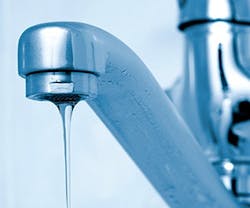Are high water bills making you blue? Reducing your water demand is a smart move because its benefits extend to many other areas of facilities management. Create a water efficiency game plan by identifying areas of high consumption and selecting the right replacements.
Flush with Opportunities
Common opportunities for water savings can be found in three places: plumbing fixtures, irrigation, and HVAC equipment.
But each facility’s usage is different, so establish your consumption rates for each area before embarking on efficiency upgrades.
“Water submeters can help break out your usage in more detail than your utility bill alone,” says Rachel Sowards, a practice area manager for Paladino and Company, a sustainability consulting firm.
You may find that because irrigation is your biggest user, upgrading controls should be a priority. In other facilities, replacing faucets or showerheads could have the biggest impact.
Water efficiency is one of the most straightforward sustainability initiatives because it typically involves one-to-one fixture replacements. Many times, investment costs can be recouped in under a year.
Low-flow urinals will provide the largest water savings per fixture, says Jeffrey Kling, a mechanical engineer with Gibbens Drake Scott, an MEP design firm. Improving sink fixtures may be as simple as adding an aerator rather than a completely new model.
“Toilets also yield strong savings, but both urinals and toilets require the upfront costs of flush valve and china replacement,” notes Kling. “Often modifications to waste piping in the plumbing chase or below the flow may be required.”
Low-flow showerheads can also have some of the quickest paybacks, adds Sowards, particularly for hotels, dorms, healthcare, or multifamily complexes. The technology has evolved to the point where it can significantly reduce water without sacrificing user satisfaction.
If you want to provide low-flow lavatory and shower upgrades, review your water distribution systems, Kling recommends. If the pipe diameter is oversized or if the fixture is far from the hot water source, it can take hot water longer to reach the fixture, wasting water as the user waits for the right temperature.
“To improve delivery time, you may need to make piping modifications in non-accessible locations,” says Kling. “Mixing valves should also be reviewed for minimum flow rates and replaced if necessary.”
As you pursue retrofits, make sure your project is in line with code considerations, stresses Kling. You must comply with a number of plumbing standards, including ASSE, IAPMO, IPC, and AWWA. HVAC replacements should also be in line with ASHRAE and IMC guidelines.
Be aware, however, that more extensive projects may be foiled or prohibited by state or regional regulations.
“For simple upgrades, you generally won’t have much pushback from local codes. But if you’re trying to capture stormwater, greywater, or condensate, you need to be aware of what’s permitted in your local jurisdiction,” Sowards notes. PageBreak
Look for WaterSense Certification
A cousin to ENERGY STAR and the only commercial certification for water efficiency, WaterSense is a product label for fixtures that reduce water consumption. Certified products are at least 20% more efficient than their traditional counterparts, which can yield significant savings and fast paybacks.
The label can be found on over 3,600 models of faucets, accessories like aerators, toilets, urinals, showerheads, and pre-rinse spray valves. It’s an easy way to cut through manufacturer claims and focus on products that have been third-party tested for performance.
The specification also applies to weather-based irrigation controllers, such as stand-alone, add-on, and plug-in devices that use current weather data and evapotranspiration as a basis for scheduling irrigation.
Since 2006, WaterSense has saved 487 billion gallons of water and over $8.9 billion in water and energy bills, reports the EPA. Reductions of 64.7 billion kWh of electricity and 24 million metric tons of carbon dioxide were also achieved.
To ensure confidence in the label, the EPA evaluates a number of factors related to environment impacts and performance. These include:
- Potential for significant water savings on a national level
- Equal or superior product performance compared to conventional models
- Ability to measure and verify water savings and performance
- Cost effectiveness
It should also be noted that products that rely on proprietary technology are not eligible for the label. All models must also comply with existing ASME and NSF/ANSI standards.
The Trickle Down Effect
When you improve your water efficiency, your building operations will gain more than just water savings – you’ll also lower greenhouse gas emissions, energy consumption, and sewer fees.
“Because hot water takes energy to produce, there’s a direct correlation between your water and energy bills,” Sowards explains. “Less energy needed also results in fewer carbon emissions emitted by your facility.”
The benefits of reducing your water demands also extends to your community. Water purification is an energy-intensive process, using anywhere from 0.25-3 kWh per 1,000 gallons to achieve potable standards. And as water infrastructure continues to age, the rising maintenance and treatment costs are passed on directly to customers.
“Any time you lower your water consumption, you also reduce the amount of water that has to be treated and transported to your facility, as well as the volume carried away by the sewer system,” says Sowards.
Just like energy efficiency, make sure saving water becomes a mindset – don’t stop with one upgrade and call it a day. Your building is flush with opportunities to save water.
You can also go beyond the basics and seek out overlooked strategies, such as drought-tolerant or native landscaping, dishwasher and garbage disposal replacement, pool covers, leak monitoring, and permeable pavement.
When sustainability was in its infancy, advocates knew that getting a person to switch to a better light bulb could be a catalyst for greater energy efficiency. Water is no different – what will changing one restroom fixture do for your facility?
Jennie Morton [email protected] is senior editor of BUILDINGS.
About the Author
Jennie Morton
A former BUILDINGS editor, Jennie Morton is a freelance writer specializing in commercial architecture, IoT and proptech.
